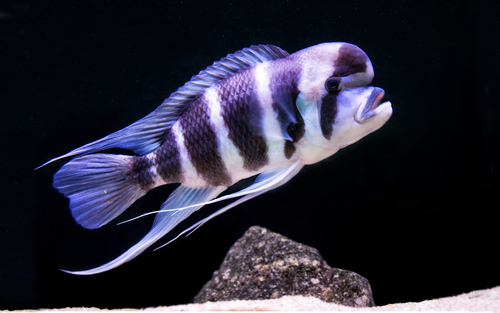If you’re a cichlid enthusiast, you’ve probably heard of the frontosa. Frontosas are highly revered in the fish community and are popular for their polychromatic exterior and their large size.
The Frontosa species is distinguished by its white and blue body, with several black bands streaked across it. Some even have gold accents! New breeding technologies have made it easier to obtain Frontosa if you want to provide a home for them!
Frontosa is one of the most amicable species of fish out there. They are lively and interactive with their owners and can even eat right out of their hands! Since they’re active, it would be good to pair your Frontosa with a tank mate that they can spend their time with. Looking for appropriate tank mates can be difficult, but luckily, we have you covered!
Many species are compatible with the Frontosa, which can be lively mates for your fish and you! We’ve searched for up 15 best Frontosa tank mates guaranteed to be amicable partners for your cichlid.
Contents
Frontosa Tank Mates – What You Need to Know
Caring for fish is a strenuous endeavour if you’re not appropriately equipped. If you want to provide a home for this peppy blue cichlid, we recommend thoroughly perusing its characteristics. We’ve listed them down for you below!
Temperament
Frontosa are pretty mild-mannered. This is one of the key aspects to consider when determining a tank mate, for overly aggressive tank mates just won’t do. Another important thing to note is that frontosa can get aggressive during the breeding season, so it is important to have enough tank space to move about.
Size
Frontosa is a large species. They can grow up to 1.1 feet and have a distinguished hump on their back which can also progressively grow as they age. The male cichlids are pronouncedly larger than the females, which can only grow up to 8 or 10 inches.
Competition
Since Frontosa are slow feeders, they do not like competing with others for food. Feeding them all their nutrients separately is better to prevent unnecessary competition. Regarding mating, the males are generally aggressive towards other males in the act of authority.
Parameters and Tank Setup
Be prepared to invest in a large tank because Frontosa love to move about! You need at least one 200-gallon tank for an adult humpback cichlid and a much larger one if you plan to keep the fish in groups. The ideal size for a group is 750 gallons.
Aside from the size, the cichlids need to be in an environment that resembles their indigenous environment. They are native to Lake Tanganyika in Africa, so the water conditions must be on par with the lake. The temperature should range from 23.3 to 26.1 degrees, primarily alkaline, with a pH of 9. Since the Lake is rich in oxygen, employing a constantly working bubbler is best.
Another aspect to consider is that Frontosa responds well to iodine, as it supports their growth and development. You can simulate this by adding iodized table salt, an amount of 14.33 grams per 40 litres. This is basically 1 tablespoon per 11 gallons of water.
15 Best Frontosa Tank Mates
It’s time to get into the main list! We’ve gathered 15 species that can be the best tank mates for your Frontosa. Keep reading below to find out!
You also shouldn’t miss these other popular posts:
- Kuhli Loach Tank Mates
- Comet Goldfish Tank Mates
- Blood Parrot Cichlid Tank Mates
- Giant Danios Tank Mates
1. Blue Dolphin Cichlid

- Scientific Name: Cyrtocara Moori
- Adult Size: 8-10 inches
- Compatible with: Clown Loaches
- Care Level: Mid-level care
- Origin: Lake Malawi
Hailing from Lake Malawi, the Blue Dolphin Cichlid is also a large variation. The lake is largely alkaline, providing a similar environment to the Frontosa, allowing the two species to thrive together. Like male Frontosa, the males have a nuchal hump on their back, bearing a resemblance.
The Blue Dolphin also matches the Frontosa’s personality! This species is mild-mannered and less aggressive than other cichlids hailing from Lake Malawi. Their living arrangements are also similar to the Frontosa, with one male living with several females in a harem-like setting.
The Blue Dolphin exclusively feeds on benthic invertebrates like snails, shrimps, amphipods and other organisms. Its nutrients should be managed, and should preferably be fed fresh and frozen food. If you’re looking to breed, brine shrimp, bloodworms and chopped shrimps are perfect foods to preserve their health!
Pros of keeping with Frontosa:
- They have a similar temperament to the Frontosa.
Cons of keeping with Frontosa:
- The different diet requires more maintenance of the feeding schedules of the two fish.
2. Jack Dempsey
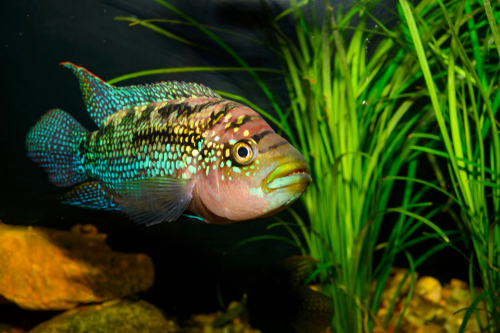
- Scientific Name: Rocio octofasciata
- Adult Size: 8-10 inches
- Compatible with: Common Plecos
- Care Level: Mid to High
- Origin: Mexico and Central America
If you’re guessing this fish got its name from the famous boxer, you’re probably right! These fish are aquarium staples and a bit hard to find, but watch out for their vicious personalities!
Jack Dempsey may be mean, but they’re not nearly as territorial as the rest of the Central American Cichlids. When paired with our friendly Frontosa, they’re tame and amicable!
Dempseys hail from similar conditions to the Frontosa, from hard alkaline waters. The Electric Blue variant is especially popular, albeit expensive. Since they’re heavily inbred, their immune system might be compromised, so maintaining their tank conditions is of utmost importance.
Dempseys love digging, so aquascape accordingly! They’re not particularly picky, so you can feed them like the Frontosa!
Pros of keeping with Frontosa:
- They have a tame personality when they’re tank mates with the Frontosa.
Cons of keeping with Frontosa:
- They are slightly more high maintenance.
3. Peacock Cichlids
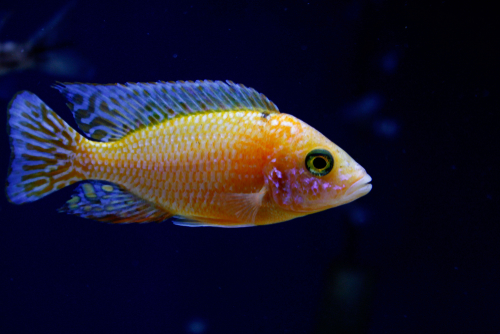
- Scientific Name: Aulonucara sp
- Adult Size: 4-6 inches
- Compatible with: Azureus Cichlid
- Care Level: Low
- Origin: Lake Malawi
This is the gentlest species that you’ll come across in Lake Malawi. They might sometimes scrap and display each other occasionally; do not expect them not to get aggressive unless you harass their younglings.
Peacocks love sifting sand and hunting for invertebrates like worms, insect larvae and other organisms. They are also vibrantly coloured and love to show off their polychromatic hues, contrasting with the shyness of their Frontosa mates.
Peacock Cichlids have numerous variants and sizes, so there’s a species out there for every aesthetic! If you want your Frontosa mate to be white, consider choosing the albino peacock. Looking for a blue variant? Aulonocara Nyassae is the one for you!
These species are the poster fish for resilience and have been tank bred for ages. While they do thrive in conditions resembling their home lake, they do just fine in aquarium conditions!
Pros of keeping with Frontosa:
- They contrast well with the Frontosa based on their aesthetic.
Cons of keeping with Frontosa:
- There aren’t any!
4. Starry Night Cichlid

- Scientific Name: Paratilapia polleni/bleekeri
- Adult Size: 12 inches
- Compatible with: Peaceful Cichlids
- Care Level: Mid
- Origin: Madagascar
Like its name, the Starry Night Cichlid is a stunning Cichlid variant. While the Madagascan fish are relatively unknown in the market, these species are an absolute delight. Their blue, black and golden hues are enough to light up the entire aquarium and leave you mesmerized!
Starry Nights are similar to Frontosas, a bit authoritative but not aggressive. They prefer fresh food and can feed on pieces of meat, carnivore pellets and live prey like worms and feeder fish.
They do not require much maintenance regarding water conditions, although you may need to regulate their pH from 6.5 to 8. This is the best tank mate if your Frontosa tank pH is 8.0!
Pros of keeping with Frontosa:
- Similar tank conditions mean both species are comfortable.
Cons of keeping with Frontosa:
- Starry nights can sometimes be authoritative!
5. Black Calvus Cichlid:
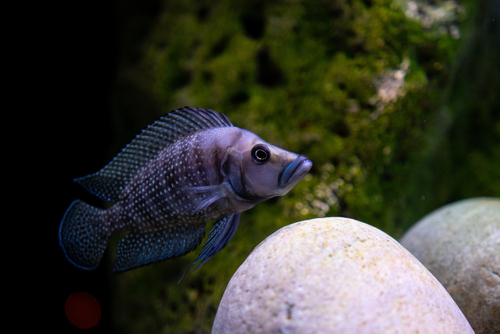
- Scientific Name: Altolamprologus calvus
- Adult Size: 5-6 inches
- Compatible with: Synodontis Catfish
- Care Level: High
- Origin: Lake Tanganyika
This is a bit of an unusual species. For starters, its scales are reverse oriented and best suited to defence. If pursued by predators, they fit themselves in a crevice and exteriorise their scales, and it becomes impossible to pull them out!
They also employ this technique against problematic tank mates, grating their scales against the fish’s bodies to separate the two. Be careful while netting, as these scales, can easily get tangled. Since Frontosa is not particularly provocative, the Black Calvus can be a good tank mate.
These species are shell spawners and not mouth brooders. They lay their eggs in large numbers and then fend for their young until they are able to hunt for themselves.
The Black Calvus species grows incredibly slowly, up to 1.5 inches annually! It takes them 3-4 years to grow to their full form.
Pros of keeping with Frontosa:
- They have a similar size to the Frontosa when they’re grown, so there is no risk of dominance.
Cons of keeping with Frontosa:
- The scales might be mildly threatening!
6. Electric Yellow Cichlid
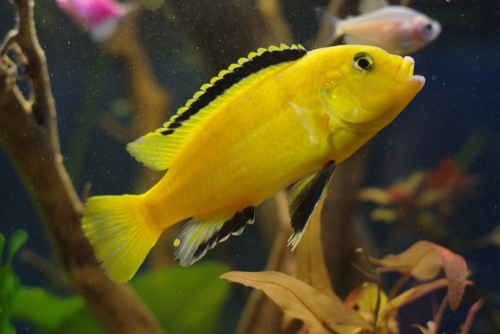
- Scientific Name: Labidochromis caeruleus
- Adult Size: 4-6 inches
- Compatible with: Synodontis Catfish
- Care Level: Mid
- Origin: Lake Malawi
Most Malawi Mbunas are too aggressive to be tank mates to Frontosas, but the Electric Yellow Cichlids are a big exception! Their yellow hues offer a pleasant contrast to the Frontosa’s black and blue. They are amicable, active and always on the lookout for food!
They are not vegetarians, and their algae diet should be supplemented with Spirulina flakes and veggies like spinach and zucchini. However, they do feed on more invertebrates than their cousins!
Pros of keeping with Frontosa:
- Their personalities are the perfect match with the Frontosa.
Cons of keeping with Frontosa:
- There are none!
7. Cuckoo Catfish
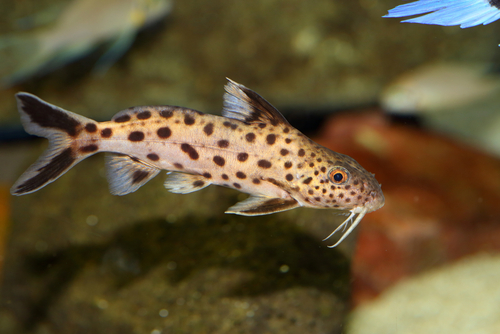
- Scientific Name: Synodontis multipunctatus
- Adult Size: 8-10 inches
- Compatible with: Malawi Fish
- Care Level: Mid
- Origin: Lake Tanganyika
Here’s a fish that’s not a cichlid on our list! You can probably guess its relationship to the Upside Down Catfish. However, unlike its Synodontis cousin, this fish swims the right side up! Like our Frontosa, these fish are also Lake Tanganyika natives!
These fish can be easily bred in aquariums and hunt in groups for their mates to spawn cichlids. They force their eggs into the cichlid mass, and cichlids often chase them out and raise the catfish alone! This is an excellent breeding strategy used by many other fish.
This is not the best species if you intend to breed your Frontosas. However, one or two are fine. These Lake Tanganyika natives make for good tank mates in a biotope aquarium!
Pros of keeping with Frontosa:
- As they are Lake Tanganyika natives, the two species are well acquainted with each other.
Cons of keeping with Frontosa:
- You might not be able to breed the Frontosa.
8. Red Irian Rainbowfish
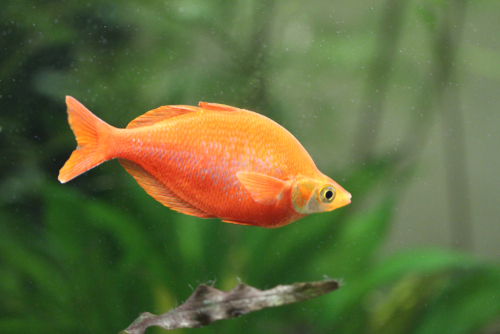
- Scientific Name: Glosolepis Incisus
- Adult Size: 6-8 inches
- Compatible with: Schooling Fish
- Care Level: High
- Origin: Lake Sentani
The name Irian is eponymous with the living grounds of these fish, Lake Irian Jaya in Indonesia. These Rainbowfish have dozens of species in their homelands.
The Red Rainbowfish are the most popular species. They are, however too small to be kept in with the Frontosas if they have not grown to their full size and risk being eaten. However, a fully formed Red Rainbowfish is about 8 inches and can otherwise make a good tank mate.
The males display a crimson hue while attracting females. You want to keep 2 females per 1 male to encourage the male and to keep the aquarium lively.
Pros of keeping with Frontosa:
- Mild-mannered Rainbowfish reduce the risk of infighting.
Cons of keeping with Frontosa:
- You may need a much larger tank.
9. Common Plecostomus

- Scientific Name: Hypostomus Plecostomus
- Adult Size: 18-24 inches
- Compatible with: Jack Dempsey
- Origin: South America
This species is an aquarium staple. They can tolerate various temperatures, conditions and makeups, including rift water lakes. Since native algae eaters aren’t widely available, the Common Plecostomus is an excellent choice.
The Common Plecos grow much larger than Rubber Plecos or Dwarf Ottos, both of which risk being consumed by your Frontosa for their small size. They may be a bit scrappy when old but don’t do any real damage due to their lack of teeth.
Common Plecos sometimes attach themselves with other cichlids to rasp mucus, but the larger cichlids quickly discourage this behaviour by shaking them off.
In addition to aquascaping with algae, you can keep them full with whole vegetables and sinking vegetarian wafers.
Pros of keeping with Frontosa:
- They have a tame personality when they’re tank mates with the Frontosa.
Cons of keeping with Frontosa:
- They may root out your aquascaping!
10. MBU Puffer Fish
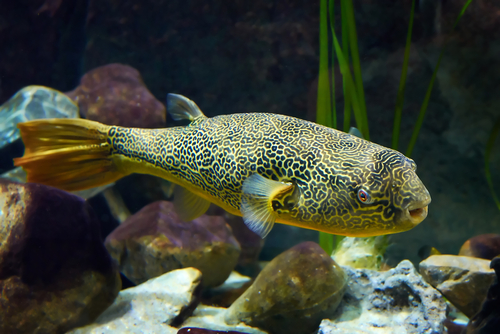
- Scientific Name: Tetraodon MBU
- Adult Size: 2 ft+
- Compatible with: Guppies
- Care Level: High
- Origin: Congo River
These fish are the largest puffers and are suited to aquariums with over 300 gallons in capacity. They are infamous for wanting large amounts of food and generating an equally large amount of waste.
These fish might be a little expensive to feed. They eat live crayfish, mussels, snails and shrimps, down to their shells. The shells wear their sharp teeth down, reducing the threats to Frontosas.
In spite of all their flaws, the MBU Puffer Fish is very personable and typically not a bother to their tank mates, thus being a good partner for the Frontosa. They are amicable to be around and love to amuse people!
Always keep the Puffer Fish well submerged. Its ability to take in air is mesmerizing but may be dangerous if the air can’t be released.
Pros of keeping with Frontosa:
- They are super personable!
Cons of keeping with Frontosa:
- They require more care than the average cichlid.
11. Clown Loach
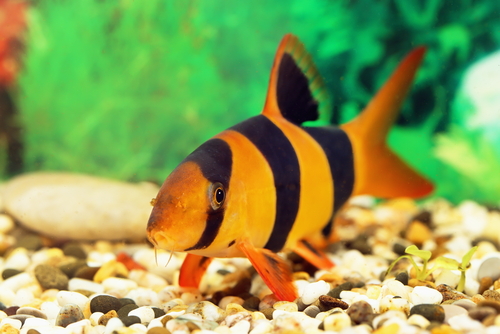
- Scientific Name: Chromobotia macracanthus
- Adult Size: 18 inches
- Compatible with: Yellow Tang
- Care Level: Moderate to High
- Origin: Indonesia
The clown loach is a large freshwater species adorning colourful stripes. It has vibrant colours and an attractive personality and is widely available to be aquarium tank buddies. They enjoy being in the company of other fish so they may be a good companion to our Frontosas!
When these fish discover that they are in danger, they typically make a chattering noise which is interesting to observe for a human. They aren’t very active and like to be peaceful, relax at the bottom of the tank, and do not disturb the ecosystem much.
Pros of keeping with Frontosa:
- They’re the ideal tank buddies!
Cons of keeping with Frontosa:
- None!
12. Rift Lake Cichlid
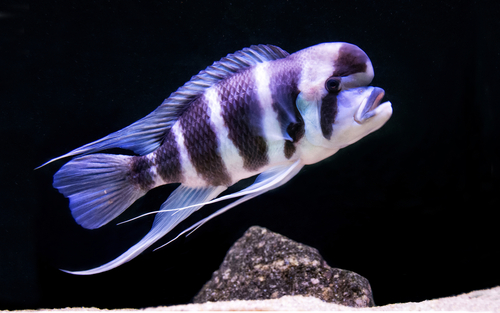
- Scientific Name: Labidochromis Ceruleus
- Adult Size: Over 4 inches
- Compatible with: Paratilapia
- Care Level: Mid
- Origin: Lake Tanganyika
Another Lake Tanganyika Native, the Rift Lake Cichlid, is an excellent tank mate. These fish might be a little territorial, so the large space you designate for Frontosas may also be an excellent abode for them.
Rift Lake Cichlids can get messy and require adequate filtration and a high level of oxygen. Both of these conditions are catered to in Frontosa tanks, so their maintenance may be on the same level.
Pros of keeping with Frontosa:
- In a large aquarium setting, they will almost never bother your Frontosa.
Cons of keeping with Frontosa:
- Watch out for the mess!
13. Bichirs
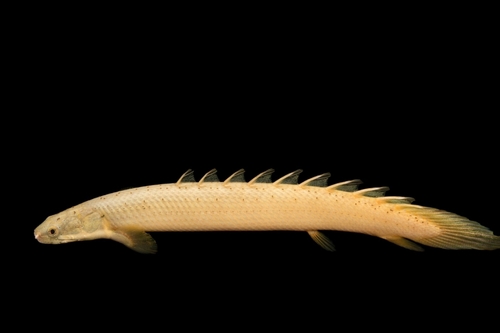
- Scientific Name: Polypteridae
- Adult Size: 11-23 inches
- Compatible with: Rainbowfish
- Care Level: High
- Origin: Central Africa
These fish have been around for a very long time. They are ray-finned fish with functional lungs and a complex system. They are not commercially bred and can be quite aggressive at times; however, they do not go out of their way to do so, and can be at peace with the Frontosa.
Bichirs require much care and maintenance, so research before procuring this species. They prefer feeding at night and have peculiar characteristics; they can walk!
Pros of keeping with Frontosa:
- They like to keep the peace in the tank.
Cons of keeping with Frontosa:
- They are high maintenance.
14. Haplochromis Cichlids
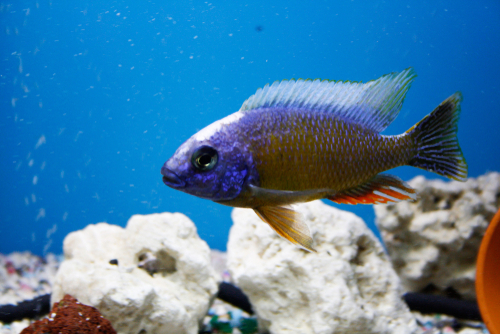
Another ray-finned genius cichlid on the list! These stunning African cichlids give off warm hues and can contrast wonderfully with the dark hues of the Frontosa. These fish provide an aesthetic experience and an amicable environment for coexistence!
Pros of keeping with Frontosa:
Their aesthetic contrasts well with the black and blue hues of the Frontosa.
Cons of keeping with Frontosa:
None!
15. Central American Cichlids

Aside from all the species listed above, you can opt for any Central American Cichlid. They are hardy, easy to care for and provide a wondrous hue to your aquarium. Who wouldn’t want to have two vibrant fish species in their aquarium!
Pros of keeping with Frontosa:
They are low maintenance!
Cons of keeping with Frontosa:
None!
Conclusion
If you’re looking for a mate for your Frontosa, look no further! We’ve detailed all the species you need to know down to their level of care, origins and general maintenance requirements so you can make an informed decision about the match in your aquarium ecosystem!

Ian Sterling, founder of Fishlab.com, began his aquarium journey over 30 years ago, driven by a deep fascination for fish and their diverse personalities. His website, Fishlab.com, is dedicated to making fishkeeping accessible and enjoyable, offering beginner-friendly guidance, expert insights, and a community for aquarists to connect and share experiences.


